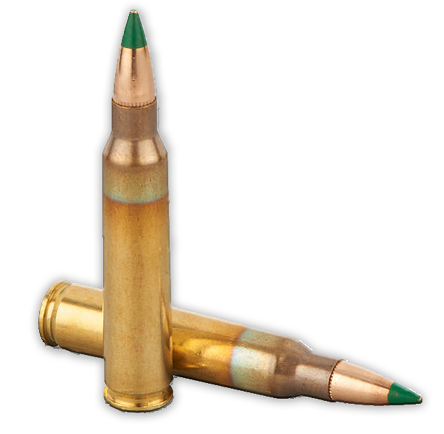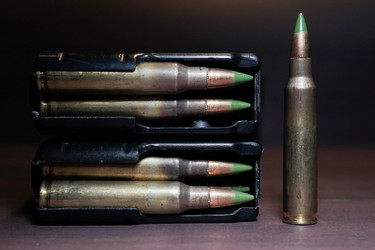M855 vs. M193: Which One's Better?
Posted by Gunbuilders.com on Jul 25th 2024
"M193 is so much better ballistically!" And, "M855 is illegal armor-piercing ammo!" Are just some of the common claims you'll see declared about two of the most popular AR-15 cartridges. But are they true? What's the difference between M855 and M193? Which one's better? Let's break it down with facts and data.
M855 vs M193: The Beginning
Both cartridges came after the .223 Remington. The .223 Rem was the civilian varmint cartridge first chambered in the AR-15 platform in 1954, before the military adopted the round. The 5.56 NATO cartridge was adopted by the US military in 1963, receiving the designation, "Cartridge, 5.56mm Ball, M193." The M855 came later, when NATO adopted the .223 Remington for European forces.
What is M193?

M193 is the standard 5.56 NATO cartridge. Weighing 55 grains, it's the most widely distributed round among US and NATO armed forces. Its a lead-cored round, featuring a full metal jacket with a muzzle velocity of 3,250 FPS and 1,294 ft. lbs. of muzzle energy. This fast, thin round quickly destabilizes when striking soft targets, often tumbling to increase wounding. It is not designed to penetrate steel, armor, or hard targets.
What is M855?

M855 was developed by Belgium's FN Herstal in 1970 to replace the then NATO-standard 7.62x51 cartridge. Designated SS109, this new variant relied on the same .223 Remington round adopted by US forces the decades prior. But unlike the lead-cored M193, the SS109 was packed with a mild steel core to move the bullet's center of gravity rearward.
This steel core helped stabilized the round and ensure it struck targets nose-first at greater distances. This was necessary to ensure the round could meet the NATO requirement that it be able to penetrate a WWII-era M1 Army helmet at 500 yards.
After being fielded by NATO, the US military would later adopt the SS109 in 1982, designating it the M855.
So, Which Round's Better?
"Better" depends on the context. The M193 cartridge is lighter, and faster out of the muzzle. Because its manufacturing process mimics that of most other modern cartridges -- being made of a copper jacketed lead core -- and because it's far more commonly issued to military units than M855, it is generally easier and more affordable to purchase.
But M855 has its own advantages. Contrary to opinions on Reddit, M193 is not "ballistically better" than M855. The opposite is, in fact, true: M855 has a higher sectional density and greater grain weight than M193. These two characteristics provide M855 with a superior ballistic coefficient, which means it retains greater velocity and accuracy at distance.
This also means M855 has an overall higher hit probability. So, in the end, it boils to the following:
M855 is more accurate than M193, but it's more expensive.
M193 is more affordable, and easier find in gun stores.
M855 vs M193: Frequent Questions
Let's cover some of the common questions -- and bust common myths -- concerning M855 and M193 ammo.
Q: Why is M855 painted with a green tip?
A: The green tip only serves to help US military service members identify and separate M855 from M193. Since each round has different ballistic characteristics, accidentally mixing the two would result in difficulties zeroing rifles at the range, inconsistent shot placement, and generally reduced accuracy.
Q: Is M855 armor-piercing?
A: M855 is not officially designed to be, nor designated as, an armor-piercing round. Although it was made to penetrate an old steel helmet at 500 yards, it does not contain the same alloys or other materials that armor-piercing rounds utilize to penetrate Kevlar and other modern soft and hard armors.
Q: Is M855 the same as SS109?
A: Yes. Both rounds utilize the same steel-cored bullets, and both rounds have the same grain weight and powder loads. The only difference is that SS109 rounds do not feature green painted tips.
Q: What is M855A1?

A: The M855A1 was developed as an improved, lead-free alternative to the M855 for the US Army. Its updated design features an exposed steel "arrowhead" tip that caps the steel core penetrator inside the copper jacket. There is no lead plug beneath the steel core, either -- only a solid copper plug.
Q: Which round is better for home defense? M855 or M193?
A: You should avoid using M855 in any home-defense or self-defense shooting scenario. Its steel core penetrator all but guarantees it will over-penetrate soft targets and likely pass through multiple walls and structures, greatly increasing the chances of collateral damage.
M855 is also less likely to produce a significant wounding channel than M193. M193's lead core reduces the risk of over-penetration, and increases the likelihood of the round fragmenting inside a soft target, producing greater lethality.
DISCLAIMER: If you are new to the world of DIY gun building, you likely have a lot of questions and rightfully so. It’s an area that has a lot of questions that, without the correct answers, could have some serious implications. At GunBuilders.com, we are by no means providing this content on our website to serve as legal advice or legal counsel. We encourage each and every builder to perform their own research around their respective State laws as well as educating themselves on the Federal laws. When performing your own research, please be sure that you are getting your information from a reliable source.

